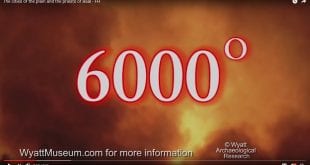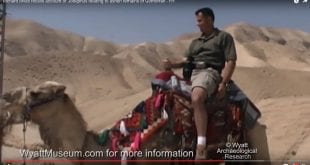(First published in newsletter # 8 in 1994)
There are those who are trying to discredit the sites of Sodom and Gomorrah by various means, such as trying to claim that sulfur balls are found in other places along the Jordan Valley. Actually, other researchers have found them more distant from but yet adjacent to the ashen remains. In fact, for purposes of argument, let’s say that sulfur is found in balls in Timbuktu (even though we haven’t found that to be the case). The fact is that NO ONE has been able to find any sulfur balls that are encased in capsules that have been on fire, most especially not in areas that are solid ash.
The sulfur (brimstone) found in these ashen remains is completely unique in the fact that these balls of sulfur are enclosed in crystalline “capsules”. Broken open, these capsules display red and black rings. In the Encyclopaedia Britannica (1985), Vol. 13, p. 816, it talks about the color changes as sulfur is heated: The colour also changes, deepening from yellow to dark red, and, finally, to black at about 250 degrees C (280 degrees F). The variations in both colour and viscosity are considered to result in changes in the molecular structure.
After the burning balls of sulfur had completely consumed their directed targets (the cities), the molten (liquid) sulfur on the outermost section of the burning ball began to cool. In the same encyclopedia referenced above, Vol IX, p. 660, we read of the process by which the crystalline capsules were formed: Monoclinic, or prismatic, sulfur, which is obtained when liquid sulfur is cooled slowly, consists of long, needle-like crystals.
And this is exactly what is found all through the ashen remains- sulfur balls surrounded by crystalline capsules of slowly cooled once-burning sulfur.
5 Sites on the Eastern Side of the Dead Sea?
Then, there is the popular theory that the 5 sites found on the plateau on the Jordanian side of the Dead Sea are the sites of Sodom and Gomorrah. (See BAR Sept./Oct. 1980, pp. 27-36.) There are several reasons- IF you believe the Biblical account- that these sites do not qualify.
The first reason is simply this- they are not “in the plain” but instead on the plateau, some 500 feet above the plain. When William Albright and Melvin Kyle discovered the site of Bab ed-Dra in 1924, they understood immediately that this site was not a candidate for Sodom, Gomorrah or any of the cities of the plain:
“It is most emphatically not a city, but rather a temporary encampment, like Gilgal, or perhaps rather like the somewhat shadowy Baal-peor of Moab. Since the plain of Bab ed-Dra is not suitable for cultivation, and is high above the gorge of the Seil ed-Dra, it would in any case be a very unsatisfactory place for a town. As a festival site for the inhabitants of the oases below it is admirable, since it is situated on the first convenient rise of terrain above the central oasis of el-Mezra`ah, some five hundred feet above the level of the Dead Sea.”(“The Archaeology of Palestine and the Bible” by William Foxwell Albright, 1932, p. 136.)
These sites show evidence of being burned, but they are NOT ash, as the Bible indicates Sodom & Gomorrah were. In fact, there is a tremendous amount of artifacts present at these sites, including carbonized grapes which still have their skins.
The 2nd reason that these sites don’t qualify as candidates for the cities of the plain is their size- the largest site, Bab ed-Dra is just 10 acres, while Numeira is only 2! Think about it- that’s not large enough to even qualify as SMALL towns. The evidence shows that these sites were indeed high places, or places visited by pilgrims. The cemetary at Bab ed-Dra is said to contain over 20,000 graves which hold over 500,000 people. Could that many people live in a 10 acre town? Of course not. But the possibility that they were high places and cemeteries of the cities of the plain is a possibility in our opinion. With the cities completely destroyed, perhaps God allowed their cemeteries and high places to remain as a testimony of the fact that an extremely large population once lived in the area.
Dr. Kyle, in his book on the exploration of the area, wrote:
“Now, brimstone is brimstone, even though used in a miracle. And a region on which brimstone was rained will show brimstone. Well, it does; we picked up pure sulfur, in pieces as big as the end of my thumb. It is mixed with the marl of the mountains on the west side of the sea, and now is to be found scattered along the shore of the sea even on the east side, some four or five miles distant from the ledge that contains the stratum. It has somehow scattered far and wide over this Plain.” (Explorations at Sodom”, by Dr. Melvin Grove Kyle, 1928, pp. 52-53.)
Dr. Kyle described the area of Sodom and Gomorrah perfectly, except he called the ashen remains, “marl”, which is an earthy deposit used as fertilizer for soils deficient in lime. Dr. Kyle and his expedition members were looking for the sites at the southern end of the Dead Sea, based not on fact but on popular conception. Yet, they passed right by the true sites. Why didn’t they notice them? Perhaps it just wasn’t God’s time.
 Wyatt Archaeological Research Ron Wyatt's Official Website – The Truth
Wyatt Archaeological Research Ron Wyatt's Official Website – The Truth


Just for a point of correction on the conversion of Celsius to Fahrenheit.
If it is 250 C then it would be 482F
Thank you Terry!